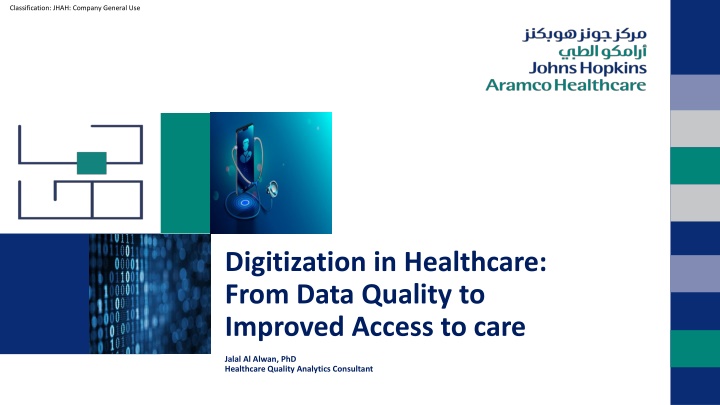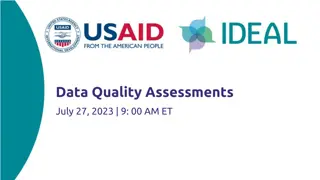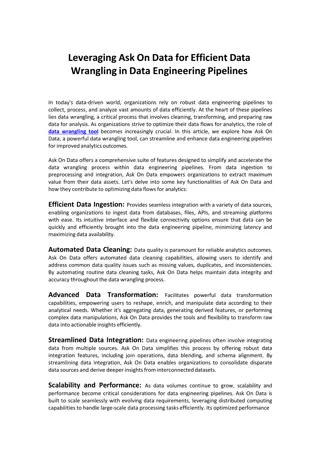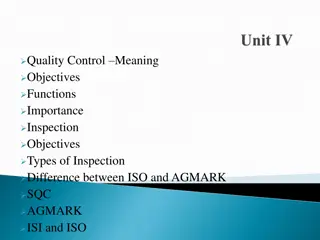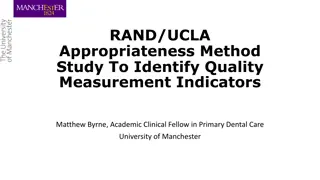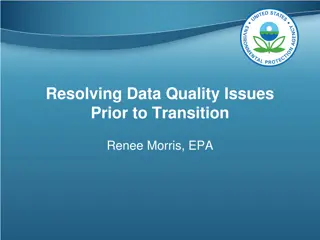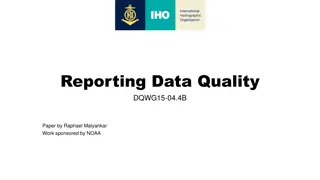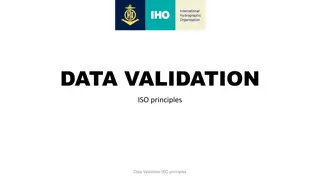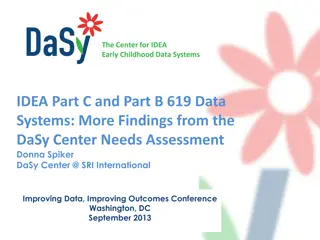From Data Quality to
JHAH Company General Use. Jalal Al Alwan, PhD Healthcare Quality Analytics Consultant, discusses the intersection of technology and healthcare, the benefits of digital health, and the impact of poor data quality on business value.
Download Presentation

Please find below an Image/Link to download the presentation.
The content on the website is provided AS IS for your information and personal use only. It may not be sold, licensed, or shared on other websites without obtaining consent from the author.If you encounter any issues during the download, it is possible that the publisher has removed the file from their server.
You are allowed to download the files provided on this website for personal or commercial use, subject to the condition that they are used lawfully. All files are the property of their respective owners.
The content on the website is provided AS IS for your information and personal use only. It may not be sold, licensed, or shared on other websites without obtaining consent from the author.
E N D
Presentation Transcript
Classification: JHAH: Company General Use Digitization in Healthcare: From Data Quality to Improved Access to care Jalal Al Alwan, PhD Healthcare Quality Analytics Consultant
Classification: JHAH: Company General Use Disclaimer The opinions expressed in this presentation and on the following slides are solely those of the presenter and not necessarily those of Johns Hopkins Aramco Healthcare (JHAH).
Classification: JHAH: Company General Use Image Source: Katarina Kamprani https://www.theuncomfortable.com/#
Classification: JHAH: Company General Use CLINICAL CARE DATA QUALITY IMPROVEMENT DIGITIZATION & INNOVATION Image Source: Katarina Kamprani https://www.theuncomfortable.com/#
Classification: JHAH: Company General Use Contents 01 06 02 07 03 08 04 09 05 10
Classification: JHAH: Company General Use What is digital health as we know it today? Digital health, or digital healthcare, is a broad, multidisciplinary concept that includes concepts from an intersection between technology and healthcare. Digital health applies digital transformation to the healthcare field, incorporating software, hardware and services. Under its umbrella, digital health includes mobile health (mHealth) apps, electronic health records (EHRs), electronic medical devices, telehealth and telemedicine, as well as personalized medicine. records (EMRs), wearable There is no denying that healthcare technology has undergone considerable changes in the last 50 years. The modern hospital is home to all manner of innovative and groundbreaking devices that have improved healthcare provision significantly and resulted in superior patient care. Without these technologies, medical professionals could not provide the level of treatment we have come to expect from first-rate health systems. Digital technology offers healthcare systems significant benefits, including better-coordinated care, real-time monitoring of chronic diseases, more accurate diagnoses, more effective treatments, and convenience for both patient and physician. Digital healthcare also delivers substantial economic benefits cost savings that can be reinvested into other priority health areas.
Classification: JHAH: Company General Use Research says ,, As organizations accelerate their digital business efforts, poor data quality is a major contributor to a crisis in information trust and business value, negatively impacting financial performance. Ted Friedman, VP Analyst, Gartner
Classification: JHAH: Company General Use Why is digital health important? What research says? Deloitte Insights digital health employs more than just technologies and tools; it also views "radically interoperable data, artificial intelligence (AI), and open, secure platforms as central to the promise of more consumer-focused, prevention-oriented care. Precedence Research projected that the global digital health market will see a compound annual growth rate (CAGR) of 27.9% from 2020 to 2027, when it will reach $833.44 billion.
Classification: JHAH: Company General Use Benefits of digital health Digital health has the potential to prevent disease and lower healthcare costs, while helping patients monitor and manage chronic conditions. It can also tailor medicine for individual patients. Healthcare providers also can benefit from advances in digital health. Digital tools give healthcare providers an extensive view of patient health by significantly increasing access to health data and giving patients greater control over their health. The result is increased efficiency and improved medical outcomes.
Classification: JHAH: Company General Use Challenges of digital health The digital transformation of healthcare has raised several challenges that affect patients, medical professionals, technology developers, policymakers and others. Due to the massive amounts of data collected from a variety of systems that store and code data differently, data interoperability is an ongoing challenge. Additional challenges relate to concerns ranging from digital literacy among patients and the resulting unequal access to healthcare to issues related to data storage, access, sharing and ownership. These concerns, in turn, raise security and privacy questions. For example, what if employers or insurers want to gather data from employees' direct-to-consumer genetic testing results? Or what if medical devices are hacked? Additional concerns relate to technology and ethics. For example, when medical robots are used, who is responsible for mistakes made during surgery: the hospital, the technology developer or manufacturer, the doctor who used the robot or someone else?
Classification: JHAH: Company General Use Regulation and patient privacy In the United States, the Health Insurance Portability and Accountability Act (HIPAA) of 1996 was written to protect patients' personal data. However, critics of those acts said they do not go far enough to limit access to patient data without consent and HIPAA regulations are often violated. HIPAA was amended in 2009 with the introduction of the Health Information Technology for Economic and Clinical Health (HITECH) Act, which was designed to make HIPAA compliance stricter. In late 2020, the U.S. Department of Health and Human Services (HHS) proposed changes to HIPAA concerning privacy and security standards that negatively affect a patient's ability to access personal health data and interfere with healthcare's transition to value-based care, a model focused on value and quality of care.
Classification: JHAH: Company General Use Sources of Savings Cont. The savings identified from digitizing Healthcare systems could come from five economic benefit pools, summarized in the illustration: making interactions virtual where appropriate, offering self-service options, increasing applications for decision intelligence workflow, and going paperless. Virtual Interactions Offering Self- services systems, automating Decision Intelligence systems Workflow automation Paperless data
Classification: JHAH: Company General Use Virtual interactions Virtual interactions constitute 41 percent of the potential benefit, producing between SAR 6 billion and SAR 9 billion in savings by 2030. These derive mainly from three types of consumer-facing solutions: Remote monitoring of chronic diseases could help providers limit the cost of caring for patients with diseases such as diabetes. If they were adopted more broadly, they could help reduce emergency admissions and improve the control of diseases Electronic triaging can department visits. Such visits, which include conditions that could be managed at home or at a primary-care clinic, currently constitute 50 percent of total emergency visits in Saudi Arabia. help reduce non-urgent emergency Virtual consultations which have an emerging adoption rate, may benefit both patients and providers. Patients enjoy the convenience and time savings of not having to travel to the secondary-care facility and wait to see a provider. And providers can use their time more efficiently, thus helping advance a value-based care agenda Source: McKinsey 2022
Classification: JHAH: Company General Use Self-care and self-service Patient self-care and self-services account for 17 percent of the potential benefit, totaling between SAR 2.6 billion and SAR 6.6 billion by 2030 Self-service solutions also give patients greater control over their access to care by allowing them to book clinic visits, reschedule appointments, and schedule diagnostic tests themselves. Such services exist today in Saudi Arabia, but many opportunities to increase adoption rates remain Source: McKinsey 2022
Classification: JHAH: Company General Use Decision intelligence systems Many KSA providers have implemented performance dashboards, but there are opportunities beyond this technology. For example, genomic profiling, when performed with robust patient privacy and safeguards, can generate a full pharmacogenomics profile from a swab that the patient performs at home. This profile can be used to identify the most compatible drug and appropriate dose for each individual, which can improve health outcomes and reduce the occurrence of adverse reactions. Another example is clinical decision support in hospitals. Many of these software solutions use machine-learning algorithms to identify patterns in a patient s clinical charts and then generate recommendations for management plans. The software can also reduce medical errors by warning physicians about potential drug interactions or contraindications. A third example is patient flow management software solutions that allow administrators to manage ward occupancy throughout the hospital with greater efficiency, preventing unnecessarily long patient stays. Source: McKinsey 2022
Classification: JHAH: Company General Use Workflow automation Future-of-work studies show that 30 to 40 percent of work in the KSA health sector could be automated by 2030 Such automation would enable professionals to focus on higher-order tasks and the empathetic, human side of care Workflow automation could improve patient experience, the quality of data for clinical decision making, and organizational healthcare. Source: McKinsey 2022
Classification: JHAH: Company General Use Paperless data Unified digital medical records promote greater efficiency by allowing healthcare professionals to focus on high value-add tasks rather than administrative ones. Inter- and intrahospital communication could also be enhanced with software that can increase productivity, replacing traditional in-person multidisciplinary committees and facilitating rapid doctor-to-doctor communication about patient care between departments and hospitals.
Classification: JHAH: Company General Use Big Data in Healthcare The digitization of health information led to the rise of healthcare big data. In healthcare, big data can provide the following benefits: The emergence of value-based care also contributes to the emergence of healthcare big data by spurring the industry to employ quality analytics to make informed business decisions. Reducing medication errors. By analyzing patient records, software can find inconsistencies between a patient's health and prescriptions and then notify health professionals and patients of a potential medication error. However, "faced with the challenges of healthcare data -- such as volume, velocity, variety, and veracity -- health systems need to adopt technology capable of collecting, storing, and analyzing this information to produce actionable insights," Aiding in preventive care. A large volume of recurring patients -- or frequent flyers -- flock to emergency rooms. Using big data analysis can help identify this type of patient and develop preventive plans to keep them from returning. Staffing more accurately. Predictive analysis could help hospitals and clinics predict admission rates so that they can improve staff scheduling.
Classification: JHAH: Company General Use What is data quality in healthcare? ISO/IEC 25012 standard: Data quality is defined as the degree to which the data fulfills any intended purpose. In the healthcare industry, medical facilities effectively use data for multiple purposes, such as: 1 2 3 4 5 Maintaining patients electronic health records (EHR), Diagnosing and treating diseases and ailments Performing research and analytics on new diseases and patient histories Efficiently designing medical policies and procedures, and Maintaining patient records for public health surveillance.
Classification: JHAH: Company General Use What are data quality requirements in healthcare? No. Characteristic Meaning Example of Data quality requirement 1 Availability and accessibility Data is available when needed and is accessible to whomever needs it. In an electronic patient record system, clinical information is readily available when needed. 2 Accuracy Data depicts reality and truth. The vital signs displayed on patient monitors are accurately transcribed in the patient s medical record. 3 Validation Data is present in the correct pattern and format, and belongs to the correct domain. Vital stats such as body temperature and blood pressure fall between acceptable ranges. 4 Completeness Data is as comprehensive as needed. Prescriptions contain the name of all prescribed drugs, along with the name of the prescriber, the date and time of the prescription and its expiry. 5 Currency Data is up-to-date or as current as possible. Diagnosis information is updated in the patient s EHR as soon as the diagnosis is made. 6 Consistency Data is the same (in terms of meaning as well as representation) across different data sources. Patient records represent the same information whether saved in EHR system or community health center. 7 Identifiability Data represents unique identities and does not contain duplicates. Every EHR has a unique identity and no duplicate records are present for the same patient. 8 Origin Data is saved with its metadata (origin and update history). History of EHRs is well-maintained, including creation date and update history (along with modification dates and modifier identity). 9 Usability Data is present in a format that is understandable by the ones who intend to use it. Manual and electronic healthcare records only contain abbreviations, codes and symbols that are approved and understandable. 10 Security and confidentiality Data is safe from unauthorized access and patient identity is kept secret wherever needed. Medical staff cannot access patient records without authorization, and data that uniquely identifies patients is hidden in publicly available records.
Classification: JHAH: Company General Use What is a data quality dimension? A metric that quantitatively measures data quality. 4 3 Data Value 2 Data Record 1 Dataset Data Source
Classification: JHAH: Company General Use Top 10 data quality metrics you should measure 1. Accuracy: how well do data values depict reality/correctness? 2. Lineage: how trustworthy is the originating source of data values? 3. Semantic: are data values true to their meaning? 4. Structure: do data values exist in the correct pattern and/or format? 5. Completeness: is your data as comprehensive as you need it to be? 6. Consistency: do disparate data stores have the same data values for the same records? 7. Currency: is your data acceptably up to date? 8. Timeliness: how quickly is the requested data made available? 9. Reasonableness: do data values have the correct data type and size? 10. Identifiability: does every record represent a unique identity and is not a duplicate?
Classification: JHAH: Company General Use A. Intrinsic data quality dimensions These dimensions directly assess and evaluate the data value at the granular level; its meaning, availability, format, and metadata, etc. These dimensions do not consider the context in which the value was stored, such as its relationship with other attributes or the dataset it resides in. Accuracy Lineage domain, structure, Following four data quality dimensions fall under intrinsic category: Semantic Structure
Classification: JHAH: Company General Use 01 Lorem Ipsum Accuracy: How Well Do Data Values Depict Reality/Correctness? 02 Lineage Accuracy of data values is measured by verifying them against a known source of correct information. This measurement could be complex if there are multiple sources that contain the correct information. In such cases, you need to select the one that is the most inclusive to your domain, and compute the degree of agreeability of each data value against the source. 03 Semantic 04 Structure 05 Completeness 06 Consistency 07 Currency
Classification: JHAH: Company General Use 01 Accuracy: How Trustworthy Is The Originating Source Of Data Values? 02 Lineage The lineage of data values is verified or tested by validating the originating source, and/or all sources that have updated the information over time. This is an important measure as it proves the trustworthiness of the data captured, and as it evolves over time. 03 Semantic 04 Structure 05 Completeness 06 Consistency 07 Currency
Classification: JHAH: Company General Use 01 Accuracy Are Data Values True To Their Meaning? 02 Lineage To ensure data quality, the data value must be semantically correct; which relates to its meaning especially in context of the organization or department it is used. Information is usually exchanged between different departments and processes in an enterprise. In such cases, stakeholders and users of data must agree to the meaning of all attributes involved in the dataset, so that they can be semantically verified. 02 Semantic 04 Structure 05 Completeness 06 Consistency 07 Currency
Classification: JHAH: Company General Use 01 Accuracy Do Data Values Exist In The Correct Pattern And/Or Format? 02 Lineage Structural analysis relates to verifying the representation of data values meaning, the values have valid pattern and format. These checks are better made and enforced at data entry and capture, so that all incoming data is first validated and if needed, transformed as required, before storing in the application. 02 Semantic 04 Structure 05 Completeness 06 Consistency 07 Currency
Classification: JHAH: Company General Use 01 Accuracy Is Your Data As Comprehensive As You Need It To Be? 02 Lineage Completeness defines the degree to which the needed data values are filled and are not left blank. This can be calculated vertically (attribute-level) or horizontally (record-level). Usually, fields are marked mandatory/required to ensure completeness of a dataset. While calculating completeness, its three different types must be considered to ensure accuracy of the results: Required field that cannot be left empty; for example, National ID of an employee. Optional field that does not necessarily need to be filled; for example, Hobbies field for an employee. Inapplicable field that becomes irrelevant based on the context of the record, and should be left blank; for example, Spouse s Name for a non- married individual. 02 Semantic 04 Structure 05 Completeness 06 Consistency 07 Currency
Classification: JHAH: Company General Use 01 Accuracy Do Disparate Data Stores Have The Same Data Values For The Same Records? 02 Lineage Consistency checks whether data values stored for the same record across disparate sources are free from contradiction, and are exactly the same in terms of meaning as well as structure and format. Consistent data helps to perform uniform and accurate reporting across all functions and operations of your enterprise. Consistency does not only relate to the meanings of data values, but also, their representation; for instance, when values are not applicable or are unavailable, consistent terms must be used to represent the unavailability of data across all sources. 02 Semantic 04 Structure 05 Completeness 06 Consistency 07 Currency
Classification: JHAH: Company General Use 01 Accuracy 02 Lineage Is Your Data Acceptably Up To Date? Currency relates to the degree to which data attributes are of the right age in context of their use. This measure helps to keep the information up-to-date and in conformance with the current world, so that your snapshots of data are not weeks or months old, leading you to present and base critical decisions on outdated information. To ensure currency of your dataset, you can set reminders to update data, or set limits to an attribute s age, ensuring all values are subjected to review and update in a given time. 02 Semantic 04 Structure 05 Completeness 06 Consistency Currency 07
Classification: JHAH: Company General Use 08 Lorem Ipsum Timeliness How Quickly Is The Requested Data Made Available? 09 Reasonableness Timeliness measures the time it takes to access the requested information. If your queried data requests take too long to finish, it could be that your data is not well-organized, related, structured, or formatted. Data quality timeliness also measures how quickly is the new information available for use across all sources. If your enterprise employs complex and time-consuming processes to store incoming data, users can end up querying and using old information at some points. 10 Identifiability
Classification: JHAH: Company General Use 08 Timeliness 09 Reasonableness Do Data Values Have The Correct Data Type And Size? Reasonableness measures the degree to which data values have a reasonable or understandable data type and size. For instance, it is common to store numbers in an alphanumeric string field, but reasonability will make sure that if an attribute only stores numbers, then it should be of number type. Moreover, reasonability also enforces maximum and minimum character limit on attributes so that there are no unusually long strings in the database. The reasonability measure reduces space for errors by enforcing constraints on an attribute s data type and size. 10 Identifiability
Classification: JHAH: Company General Use 08 Timeliness Does Every Record Represent A Unique Identity And Is Not A Duplicate? 09 Reasnonability Identifiability calculates the degree to which data records are uniquely identifiable and are not duplicates of each other. To ensure identifiability, a uniquely identifying attribute is stored in the database for each record. But in some cases, such as the case of healthcare organizations, personally identifiable information (PII) is removed to guard patient confidentiality. This is where you may need to perform fuzzy matching techniques to compare, match, and merge records. Identifiability 10
Classification: JHAH: Company General Use Take a ways 1 2 3 Digitization will reshape the current healthcare model worldwide. The new model is finally moving away from reactively treating illness to proactively promoting wellbeing and prevention. This is not only good for patients but also reduces cost of care significantly to release the pressure on the healthcare systems themselves. Insight from human genetics, precision and patient centered care will transform healthcare, brining value through innovative biotechnology and requiring the healthcare eco system to move away from looking at the average patient to looking at the individual patient. By end 2023 healthcare is expected to be fully predictive, preventative, personalized and participatory.
Classification: JHAH: Company General Use 1971 Ground rounds/ Dr. Larry Weed How can the health record help guide and teach us?
Classification: JHAH: Company General Use How can the health record help guide and teach us?
